|
Printables |
PowerPoints |
Online exercises |
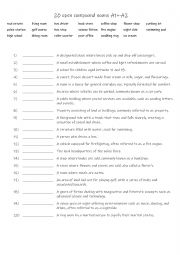
|
20 open compound nouns
Students read the decription and select the correct open compound noun in bold. To help students realise that compund nounds have different forms etc.Joined, hypenated and open. The worksheet is also suitable as a warmer / cooler or gap fill in suitable classes. Answers on page 2
Level: elementary
Age: 10-100
Type:
Downloads: 109
|
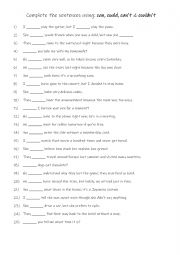
|
Ability, complete the sentences using: can, could, can�t & couldn�t
Students read the sentences and decide if present or past form is required. Then theycomplete the gap fills using: can, could, can�t & couldn�t. Answers on page 2
Level: elementary
Age: 10-100
Type:
Downloads: 109
|
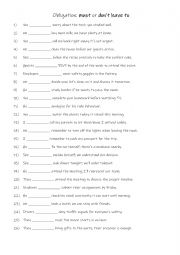
|
Obligation: must or don�t have to
Students read the sentence to work out if the missing word needs to be completed with either must or don�t have to.This worksheet is suitable for A2 students. Answers on page 2.
Level: elementary
Age: 9-100
Type:
Downloads: 109
|
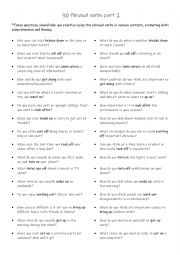
|
30 Phrasal verbs part 1 b
This is a speaking reinforcement activity for the phrasal verbs in Part 1 A. It contains 2 questions for each of the 30 phrasal verb. Suitable for pair work or small groups.This worksheet is suitable for CEFR A2-B1 level students.
Level: elementary
Age: 10-100
Type:
Downloads: 109
|
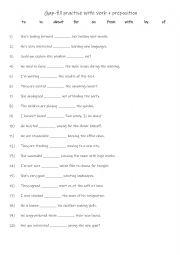
|
A2+-B1 Gap-fill practise with verb + preposition (1)
The gap-fill exercise provided is suitable for A2+-B1 level students. It involves common prepositions and phrases that are often used in everyday contexts, making it appropriate for learners who have a solid grasp of basic grammar and are ready to tackle more nuanced uses of prepositions. Answers on page 2.
Level: intermediate
Age: 10-100
Type:
Downloads: 109
|
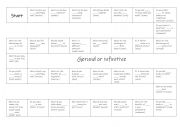
|
Gerund or infinitive?
This worksheet is intended to get students to use gerunds / infinitives in conversational settings. The topics are about up-to-date topics of interest. Speaking exercises provide a chance for students to use gerunds and infinitives in real-time conversation, which helps improve their fluency and comfort with these structures. By repeatedly practici...
Level: intermediate
Age: 12-100
Type:
Downloads: 109
|
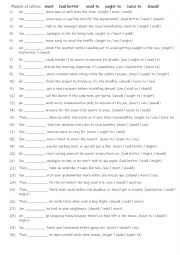
|
A2+-B1+ 6 Modals for advice
Students read the sentences and complete the gap-fill with the most suitable modal of advice: must,had better,need to, ought to, have to & should. Answers on page 2.
Level: intermediate
Age: 8-100
Type:
Downloads: 109
|
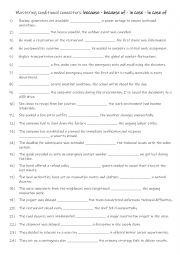
|
B1-B2 Mastering conditional connectors: because - because of - in case - in case of
Learning how to use because, because of, in case, and in case of offers significant benefits for both spoken and written English, as they help students clarify cause, reason, and conditions in different contexts.Mastering these phrases allows students to explain reasons and conditions more clearly, enhance their formal and informal communication, a...
Level: intermediate
Age: 10-100
Type:
Downloads: 109
|
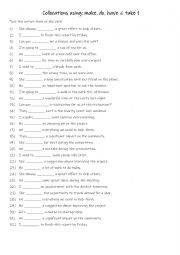
|
A2-B1 Collocations using make, do, have & take 1
Learning collocations with make, do, have, and take is important because they help you speak and write more naturally and fluently in English. These verbs often pair with specific nouns or phrases, and using them correctly improves your communication. For example, "make a decision", "do homework", "have a conversation", and "take a break" are commo...
Level: elementary
Age: 9-100
Type:
Downloads: 109
|
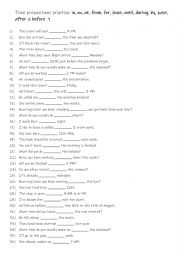
|
A2-B1 Time prepositions practise in, on, at, from, for, since, until, during, by, past, after & before 1
Learning time prepositions like in, on, at, from, for, since, until, during, by, past, and after is important for students because they are essential for expressing time relationships clearly and accurately. These prepositions help students talk about when things happen, how long actions last, and their sequence in time. Mastering them allows stude...
Level: intermediate
Age: 8-100
Type:
Downloads: 109
|
|
|
|
|












